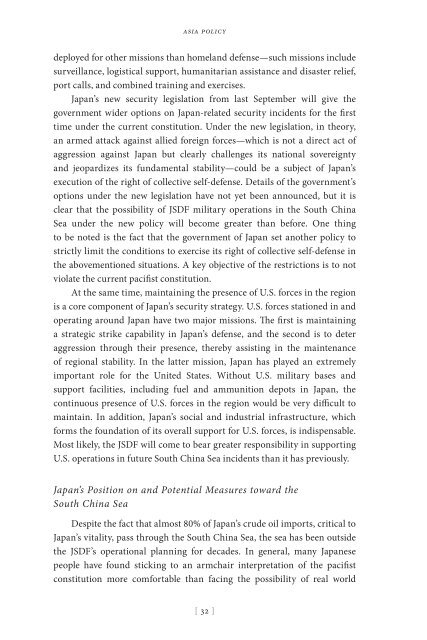Create successful ePaper yourself
Turn your PDF publications into a flip-book with our unique Google optimized e-Paper software.
asia policy<br />
deployed for other missions than homeland defense—such missions include<br />
surveillance, logistical support, humanitarian assistance and disaster relief,<br />
port calls, and combined training and exercises.<br />
Japan’s new security legislation from last September will give the<br />
government wider options on Japan-related security incidents for the first<br />
time under the current constitution. Under the new legislation, in theory,<br />
an armed attack against allied foreign forces—which is not a direct act of<br />
aggression against Japan but clearly challenges its national sovereignty<br />
and jeopardizes its fundamental stability—could be a subject of Japan’s<br />
execution of the right of collective self-defense. Details of the government’s<br />
options under the new legislation have not yet been announced, but it is<br />
clear that the possibility of JSDF military operations in the South China<br />
Sea under the new policy will become greater than before. One thing<br />
to be noted is the fact that the government of Japan set another policy to<br />
strictly limit the conditions to exercise its right of collective self-defense in<br />
the abovementioned situations. A key objective of the restrictions is to not<br />
violate the current pacifist constitution.<br />
At the same time, maintaining the presence of U.S. forces in the region<br />
is a core component of Japan’s security strategy. U.S. forces stationed in and<br />
operating around Japan have two major missions. The first is maintaining<br />
a strategic strike capability in Japan’s defense, and the second is to deter<br />
aggression through their presence, thereby assisting in the maintenance<br />
of regional stability. In the latter mission, Japan has played an extremely<br />
important role for the United States. Without U.S. military bases and<br />
support facilities, including fuel and ammunition depots in Japan, the<br />
continuous presence of U.S. forces in the region would be very difficult to<br />
maintain. In addition, Japan’s social and industrial infrastructure, which<br />
forms the foundation of its overall support for U.S. forces, is indispensable.<br />
Most likely, the JSDF will come to bear greater responsibility in supporting<br />
U.S. operations in future South China Sea incidents than it has previously.<br />
Japan’s Position on and Potential Measures toward the<br />
South China Sea<br />
Despite the fact that almost 80% of Japan’s crude oil imports, critical to<br />
Japan’s vitality, pass through the South China Sea, the sea has been outside<br />
the JSDF’s operational planning for decades. In general, many Japanese<br />
people have found sticking to an armchair interpretation of the pacifist<br />
constitution more comfortable than facing the possibility of real world<br />
[ 32 ]


